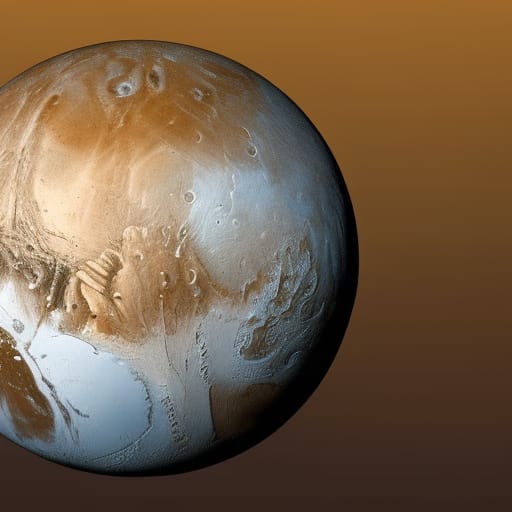Space: Pluto

Pluto, once considered the ninth planet in our solar system, was reclassified as a dwarf planet in 2006 by the International Astronomical Union (IAU). Despite its demotion, Pluto remains a fascinating and important object in our solar system. Here are the significant aspects of Pluto:
Distance and size: Pluto is located about 5.9 billion kilometers (3.7 billion miles) from the Sun on average. It has a diameter of approximately 2,377 kilometers (1,477 miles), making it smaller than Earth's Moon.
Composition: Pluto is composed primarily of rock and ice, with a surface covered in a mixture of frozen nitrogen, methane, and carbon monoxide. Its thin atmosphere consists mainly of nitrogen, with small amounts of methane and carbon monoxide, which can freeze and fall to the surface as the planet moves away from the Sun.
Orbital and rotation period: Pluto has a highly elliptical orbit that takes approximately 248 Earth years to complete. Its orbit is also inclined, meaning it doesn't lie in the same plane as the planets. Pluto's rotation period is about 6.4 Earth days, and it rotates in the opposite direction of its orbit around the Sun (retrograde rotation).
Temperature: Pluto's surface temperature averages around -229°C (-380°F), making it one of the coldest objects in our solar system.
Surface features: Pluto's surface is characterized by a diverse landscape that includes vast plains, icy mountains, and large, deep canyons. One of the most recognizable features on Pluto's surface is the heart-shaped region known as Tombaugh Regio, named in honor of Pluto's discoverer, Clyde Tombaugh. This region contains a large plain called Sputnik Planitia, which is made of nitrogen ice.
Moons: Pluto has five known moons: Charon, Nix, Hydra, Kerberos, and Styx. Charon, the largest moon, is about half the size of Pluto and shares a unique mutual tidal locking with the dwarf planet, meaning both objects always show the same face to each other.
Exploration: NASA's New Horizons spacecraft conducted a flyby of Pluto in 2015, providing the first close-up images and data on this distant world. The data collected by New Horizons revealed a wealth of information about Pluto's geology, composition, and atmosphere, as well as its moons.
Observing Pluto: Pluto is not visible from Earth with the naked eye and requires a powerful telescope to observe. Even with a telescope, Pluto appears as a small, faint point of light.
Mythology: Pluto is named after the Roman god of the underworld, equivalent to the Greek god Hades. The name was chosen in part because the first two letters, "P" and "L," are also the initials of Percival Lowell, the astronomer who predicted the existence of a ninth planet and initiated the search that led to Pluto's discovery.
Dwarf planet status: In 2006, the IAU redefined the criteria for planethood, which led to Pluto's reclassification as a dwarf planet. The decision was based on the fact that Pluto has not "cleared its orbit" of other debris, as it shares its orbital region with other objects in the Kuiper Belt. This reclassification remains a topic of debate among some astronomers and the general public.